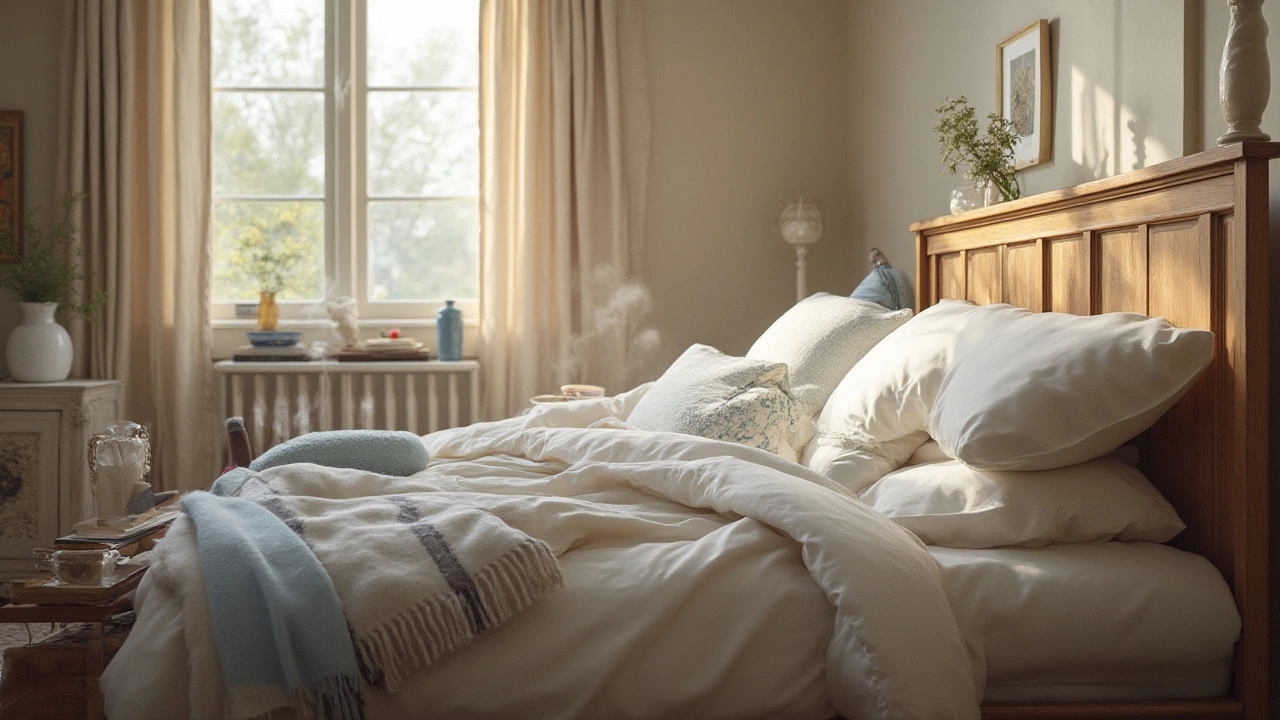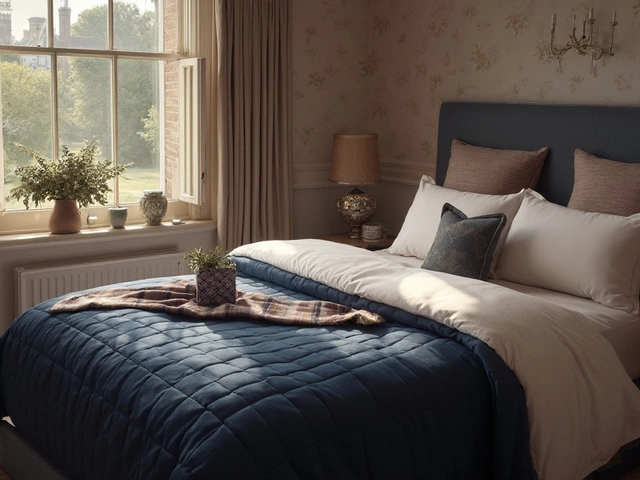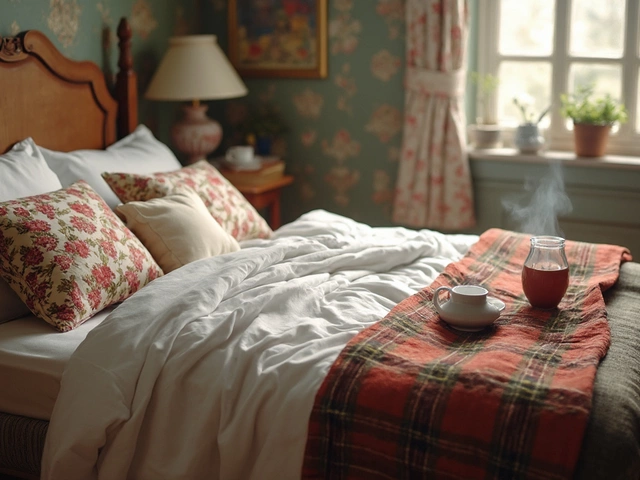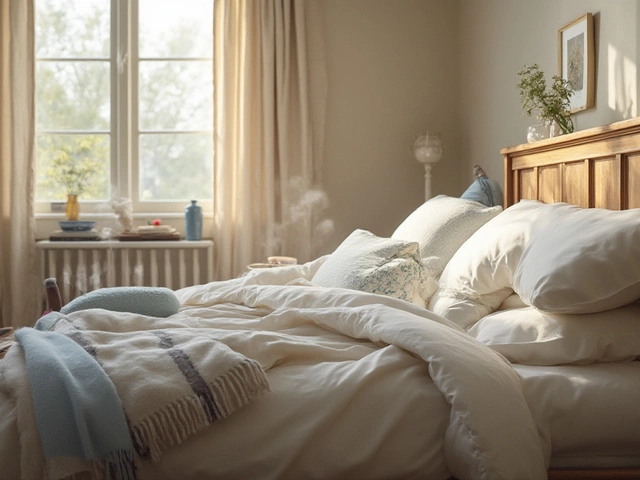Picture this: you climb under cozy sheets after a long, exhausting day, and everything just feels right. But if you start to think about it, 'bedding' is one of those words that gets thrown around a lot, but half the time, people aren’t sure what actually counts as 'bedding.' Is it just the sheet? Does it include the fluffy duvet? What about the pile of pillows you strategically toss around for 'aesthetic' reasons? Funny enough, the concept of bedding has been around for literally thousands of years, and yet, its definition is still tricky for some. Get this—ancient Egyptians were sleeping on linen sheets way back in 3000 BCE. Think of all the evolution that’s happened since. And there’s a lot to cover, from materials to maintenance, and what turns a bed from a basic rectangle into a haven you never want to leave.
What Does Bedding Actually Mean?
Let’s set the record straight—bedding isn’t just one thing. It’s the entire package of layers you put on your mattress for sleep and comfort. The basics include bed sheets (flat and fitted), pillowcases, blankets, duvets or comforters, and sometimes extras like bed skirts or mattress toppers. Everyone knows about sheets and blankets, but terms like 'duvet' or 'coverlet' trip people up all the time. Here’s an example: in New Zealand, a 'duvet' is a must-have for those chilly winters, but over in the U.S., you might hear the word 'comforter' instead. So, region matters too.
The purpose of bedding goes beyond looking pretty (even though who doesn't love a fancy hotel bed look). Bedding controls temperature, helps keep your mattress clean, and adds texture or coziness—basically, it makes your bed inviting. There’s actual science behind this: sleeping in clean, comfortable bedding can improve sleep quality, lower stress, and might even boost your mood. A study published in the National Sleep Foundation’s 2023 Sleep in America Poll found that people changed their sheets more often during stressful seasons, making their sleep noticeably better.
So when someone asks what bedding is, it’s not just your grandmother’s quilt or that set of mismatched pillowcases from uni. It’s the whole sleep setup—and it’s so personal. Someone’s idea of luxury could be crisp percale, while another’s is all chunky knits and flannel. Bedding is a reflection of your comfort, style, and, let’s be honest, your laundry habits.
Types of Bedding and What Makes Up a Complete Set
The bedding world is anything but boring. Dip your toes into any linen shop, and the options are mind-boggling. Still, a typical set usually starts with sheets—fitted to hug the mattress and flat to lay on top. Then there are pillowcases, which do double duty: keeping your pillows clean and giving a punch of color or pattern. Blankets, quilts, duvets, comforters—they’ve all got their unique charm. Take duvets, for example: they’re basically fluffy bags filled with down, feathers, or synthetic stuff, usually tucked into a cover. Comforters, on the other hand, come as a single sewn-together piece. Not to forget decorative throws and shams that add flair or help with extra warmth.
Here’s a quick breakdown of the most common bedding pieces:
- Bedding: The all-encompassing term for everything on your bed, except the mattress itself.
- Fitted Sheets: Elastic corners hold them snug around the mattress.
- Flat Sheets: Sit between you and the blanket or comforter.
- Pillowcases: Designed to protect pillows, available in standard or king sizes.
- Blankets: Thin or thick, made of wool, cotton, or synthetics.
- Duvets & Duvet Covers: Duvet goes inside the cover, making it easy to wash and swap styles seasonally.
- Comforters: Duvet alternative, usually not removable from their outer fabric.
- Quilts: Multiple layers stitched together, lightweight yet warm.
- Mattress Pads/Toppers: Add comfort, can help prolong mattress life.
- Bed Skirts: Hide the space under the bed, add a finished look.
Ever wondered what makes a 'complete' bedding set for that magazine-worthy bed? Here’s the basic formula: two sheets (one fitted, one flat), at least two pillowcases, a blanket, a top layer (duvet, quilt, or comforter), and maybe a decorative throw. Extras like Euro shams and accent cushions are up to personal taste—they’re the icing on the bedding cake.
If you want to get specific with sizes, check this quick table for standard dimensions in centimeters, which are the norm in New Zealand:
| Bedding Item | Single | King Single | Queen | King |
|---|---|---|---|---|
| Fitted Sheet | 91 x 190 x 40 | 107 x 203 x 40 | 152 x 203 x 40 | 168 x 203 x 40 |
| Flat Sheet | 180 x 260 | 200 x 260 | 245 x 274 | 260 x 274 |
| Duvet Cover | 140 x 210 | 180 x 210 | 210 x 210 | 245 x 210 |
So if you ever wondered if your old Star Wars pillowcase counts, technically yes—it’s still bedding, even if it doesn’t match the rest. At the end of the day, there’s no 'correct' number of pieces; it’s about what feels right for you and the climate you’re living in.
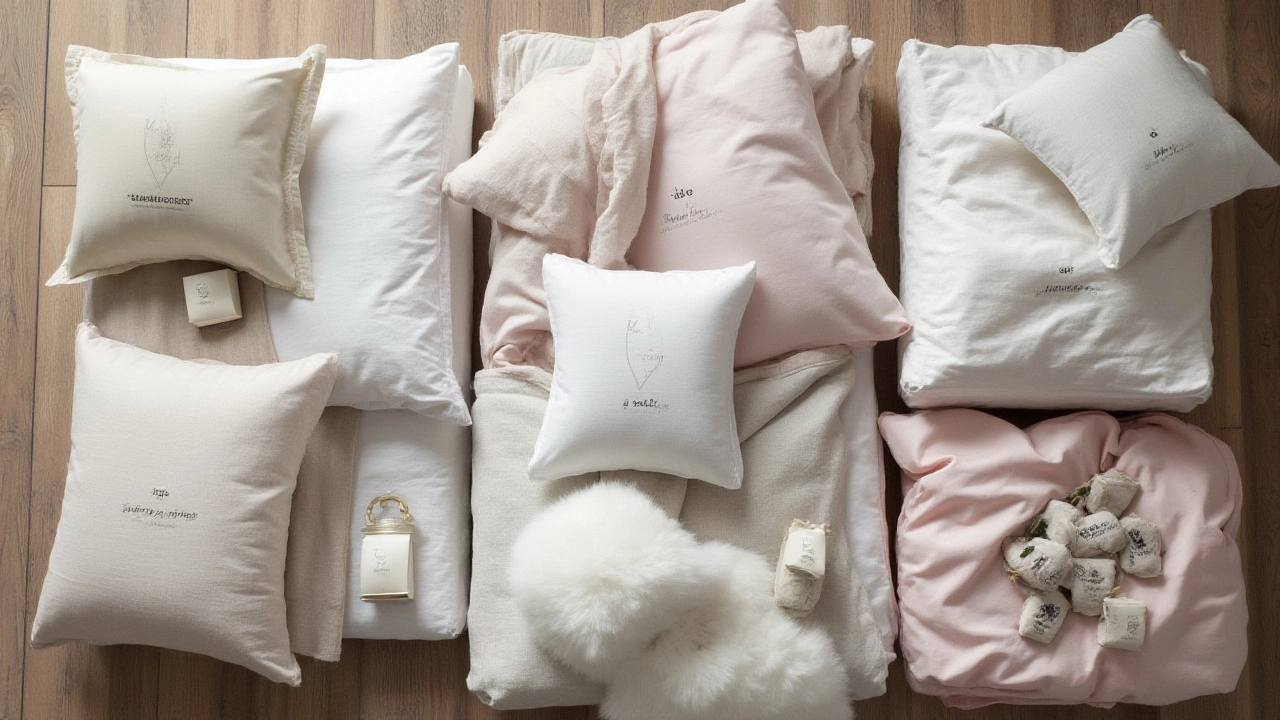
Bedding Materials: Fabric Choices and How They Really Matter
The world is obsessed with thread count, but there's a whole lot more to bedding materials than that. Most people know about cotton, but choices don’t stop there. There’s linen, flannel, silk, bamboo, polyester, and even blends—each with a personality of its own. Cotton is a favorite because it’s breathable and soft—Egyptian or Supima cotton is the crème de la crème, and lasts ages when cared for. Linen is beloved in coastal places like Auckland because it stays cool in muggy weather and gets softer every wash. One funny fact: linen sheets used to be a wedding gift tradition, as they were considered a sign of luxury and good marriage luck!
Flannel is the hero for cold Kiwi nights—think of it as a cozy hug you can’t get out of, while silk screams luxury but asks for more careful washing. Bamboo sheets are newer on the scene, for those going green—they’re sustainable, hypoallergenic, and surprisingly soft. Then you’ve got polyester and microfiber, which are budget-friendly, wrinkle-resistant, and can last forever if you’re not a sweaty sleeper.
Here's a quick rundown of popular bedding fabrics, what they're good for, and a couple of things to keep in mind when you’re choosing:
- Cotton: Classic, long-lasting, cool in summer, softens with washes. Egyptian cotton is king for smoothness.
- Linen: Super-durable, gets even softer over time, perfect for humid places.
- Flannel: Warm, fuzzy, and best for winter. Can pill after lots of use, but worth it for chillier climates.
- Silk: Naturally hypoallergenic, keeps you cool or warm as needed. More delicate, needs special washing.
- Bamboo: Eco-friendly, soft, wicks moisture. Slightly pricier, but good for those with allergies.
- Polyester/Microfiber: Inexpensive, resists stains and wrinkles, can be less breathable for hot sleepers.
- Blends: Often mix two or more fabrics to balance cost, feel, and practicality.
Your sleep isn’t just about how tired you are—it’s about your environment too. A study from the University of Sydney in 2022 found people sleeping on natural fibers like cotton or linen reported five percent higher satisfaction in sleep quality, compared to synthetic blends. That sounds tiny but multiply it by days in a year, and you’re in for better mornings. It’s worth investing in at least one good set of breathable sheets, especially if you live in places with changeable weather like Auckland. Tip: always check washing labels before splurging, because high-maintenance bedding will eat up your weekend hours if you’re not careful.
If you have allergies, don’t ignore materials. Choose hypoallergenic fabrics (like bamboo or silk), wash your bedding often, and steer clear of heavy feather duvets if you’re sensitive to dust mites.
How to Choose, Use, and Care for Your Bedding
So you’re convinced to give your bed a glow-up, but the store aisles or online options make your head spin—is Egyptian cotton really worth the price? Do you need a flat sheet, or can you skip it? It’s easy to get lost, so here are solid, no-nonsense tips for picking bedding that works for you.
- Start with the climate. Do you wake up freezing or sweaty? Choose sheets and blankets that suit your environment—flannel or quilts for cold, cotton or linen for heat.
- Think of your skin and any allergies. Hypoallergenic fabrics are your friends if sniffles or rashes are a problem.
- Get real about your lifestyle. Fancy silk is amazing but high-maintenance. Machine-washable cotton or bamboo fits a busy schedule.
- Don’t get fixated on thread count alone. Anything above 400 is really just marketing—fabric quality and weave matter more.
- Try before you buy when possible. Touch the fabric in-store or buy smaller items like pillowcases to do a test run.
When it comes to caring for your bedding, consistency wins over perfection. Change sheets every one to two weeks—more if sharing with pets or if you sweat a lot. Duvet covers can run a little longer, but give them a monthly wash. Most sheets can be washed in cold or warm water, with a mild detergent; skip the fabric softener for breathable fabrics like cotton or linen, as it can leave residues. And yes, your pillows need a bath, too—every three to six months, depending on the material.
Here’s a quick step-by-step for making your bed feel like those fancy hotel suites:
- Start with a clean, fitted sheet—smooth out the wrinkles with your hand if there’s no time to iron.
- Add your flat sheet, tucking the ends under for a crisp look.
- Layer with your blanket or duvet, folding the top down if you like the classic 'turn-down' style.
- Arrange pillows—sleeping ones in the back, then any decorative or Euro pillows at the front.
- Toss on a throw or extra blanket across the end for style (and warmth, if needed).
Here’s a stat that might convince you to step up your bedding game: a 2024 survey in New Zealand found that people who took 10 minutes each morning to tidy up their beds reported 12% lower stress levels by lunchtime. A tidy bed signals your brain that there’s order, making it easier to start your day with some calm—small ritual, big impact.
So when anyone starts to get complicated about the word 'bedding,' just remember, it’s the stuff that sits between 'just a mattress' and 'I never want to get out of bed.' The right sheets, the right layers, and a little care—it’s how you build your own comfort zone, night after night.
